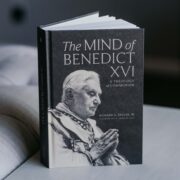I keep up with news related to disability by using Google Alerts. If you’ve never used them, they’re a great way to make sure you know about any new article that appears online related to a topic you are interested in. Google sends me a digest each day of articles that are relevant to the topics I have requested.
One of the topics I have asked to be alerted about is euthanasia. I oppose using that word since it attempts to sanitize something horrifically evil with a timbre of compassion. Its Greek root, euthanatos, literally means good or easy death. Nevertheless, it has found its way into the way our language expresses the act of killing people who ask to die. It is a word whose application has tragically jumped from the animal kingdom to humans.
This is a sample of articles I recently received from Google on this topic:
“Belgian bishop: ‘Euthanasia is not necessarily an evil as such’” | Catholic News Agency
Euthanasia: Right to die with dignity | The Sun Nigeria
Oscar, my beloved dog, has died at 15. A piece of my heart rests with him beneath the pear tree.
Of course, the first headline is confusing and alarming, but we’ll get to that later. The second is oxymoronic. The last one is just bizarre, but it helps to make an important point.
These headlines aggregate euthanizing pets along with articles on killing people who no longer feel like their lives are worth living. Common sense, rooted in the natural moral law, has been overrun by the constant creep of secularizing forces that no longer see a transcendent value to human life.
Killing people who are old or sick is not new in history, but its return is fairly recent. It left us with the coming of Jesus Christ but has returned with the new paganism and its preoccupation with death. Like killing children in the womb, our repaganized culture has become fixated on manipulating life and death in an effort to become the master of both.
The killing of young children and the intellectually disabled calls into question how well consent is enforced.
In the cultural upheavals of the 1960s and 70s, there were some on the radical fringes of progressive society already advocating for the right to kill people. No one really took them seriously, but we probably should have. The Society for the Right to Die was founded in 1974 as the successor of the Euthanasia Society of America, which had been founded thirty-six years earlier in 1938. Among its trustees were Dr. Clarence Cook Little of the American Society for the Control of Cancer and of the American Birth Control League, and Leon Fradley Whitney of the American Eugenics Society. Euthanasia and eugenics. To most people, such horrific ideas were abhorrent. Once, we had a shared understanding that God held the life and death of humanity in his own hands, and that wasn’t something we dared presume to ourselves.
In 2002, the Netherlands became the first country to pass a law allowing for euthanasia and assisted suicide when a patient was suffering unbearable pain, their illness was incurable, and they were capable of consent. If the distinction between these two terms isn’t clear, assisted suicide is when someone provides the means for another to kill themselves. Euthanasia is the direct killing of someone by another person. Almost always, healthcare professionals are involved in both.
When the Netherlands passed its 2002 law, they set themselves on a slippery slope. In April 2023, the Netherlands expanded their law to allow for the killing of children between one and twelve years old. I’ve written before that it has been discovered that some individuals with autism and other intellectual disabilities were granted their wish to die because doctors claimed their complaints (mainly loneliness) weren’t resolvable. The killing of young children and the intellectually disabled calls into question how well that third criterion of the law, that of consent, is enforced. A very dangerous slippery slope, indeed. Sliding down the same slope, it has recently been reported that Canada is soon to approve mental illness, possibly including drug addiction, as a justified reason for ending lives.

Euthanasia is not yet legal in any state in the United States, but in 1997, Oregon became the first state to legalize physician-assisted suicide. There are now eleven jurisdictions in the US that allow doctors to help their patients kill themselves. New Mexico became the most recent in 2021. Compassion and Choices is the leading organization in the US advocating for the right to physician-assisted suicide. A couple of the headlines at their website leave a thinking person scratching their head in confusion: “Is medical aid in dying safe?” and “How does medical aid in dying benefit society?” We know that something safe doesn’t result in death, and that a society that allows doctors to help patients kill themselves is symptomatic of a graver sickness that may, indeed, be terminal, but on a much larger cultural scale than any individual’s terminal disease.
The Church couldn’t be clearer in its teaching on euthanasia and physician-assisted suicide. The 1980 Vatican Declaration on Euthanasia prefaces its prohibition with a beautiful statement on the value of human life:
Human life is the basis of all goods, and is the necessary source and condition of every human activity and of all society. Most people regard life as something sacred and hold that no one may dispose of it at will, but believers see in life something greater, namely, a gift of God’s love, which they are called upon to preserve and make fruitful. And it is this latter consideration that gives rise to the following consequences:
1. No one can make an attempt on the life of an innocent person without opposing God’s love for that person, without violating a fundamental right, and therefore without committing a crime of the utmost gravity.
2. Everyone has the duty to lead his or her life in accordance with God’s plan. That life is entrusted to the individual as a good that must bear fruit already here on earth, but that finds its full perfection only in eternal life.
3. Intentionally causing one’s own death, or suicide, is therefore equally as wrong as murder; such an action on the part of a person is to be considered as a rejection of God’s sovereignty and loving plan. Furthermore, suicide is also often a refusal of love for self, the denial of a natural instinct to live, a flight from the duties of justice and charity owed to one’s neighbor, to various communities or to the whole of society – although, as is generally recognized, at times there are psychological factors present that can diminish responsibility or even completely remove it. However, one must clearly distinguish suicide from that sacrifice of one’s life whereby for a higher cause, such as God’s glory, the salvation of souls or the service of one’s brethren, a person offers his or her own life or puts it in danger (cf. Jn. 15:14).
So what about that Belgian bishop who thinks that there is room for discernment in the killing of another? He is in dissent from the Church’s teaching on the topic. Something that is intrinsically evil cannot at any point be discerned as a good. Pray for him and for any he might mislead by his comments.
The mission of Word on Fire is to form lay evangelists to bring the good news of Jesus Christ to our culture. There is no context in which euthanizing pets and persons can be considered together, and there is no more important task before us than to help others understand that by reasserting the intrinsic value of every human life. We have our work to do.
